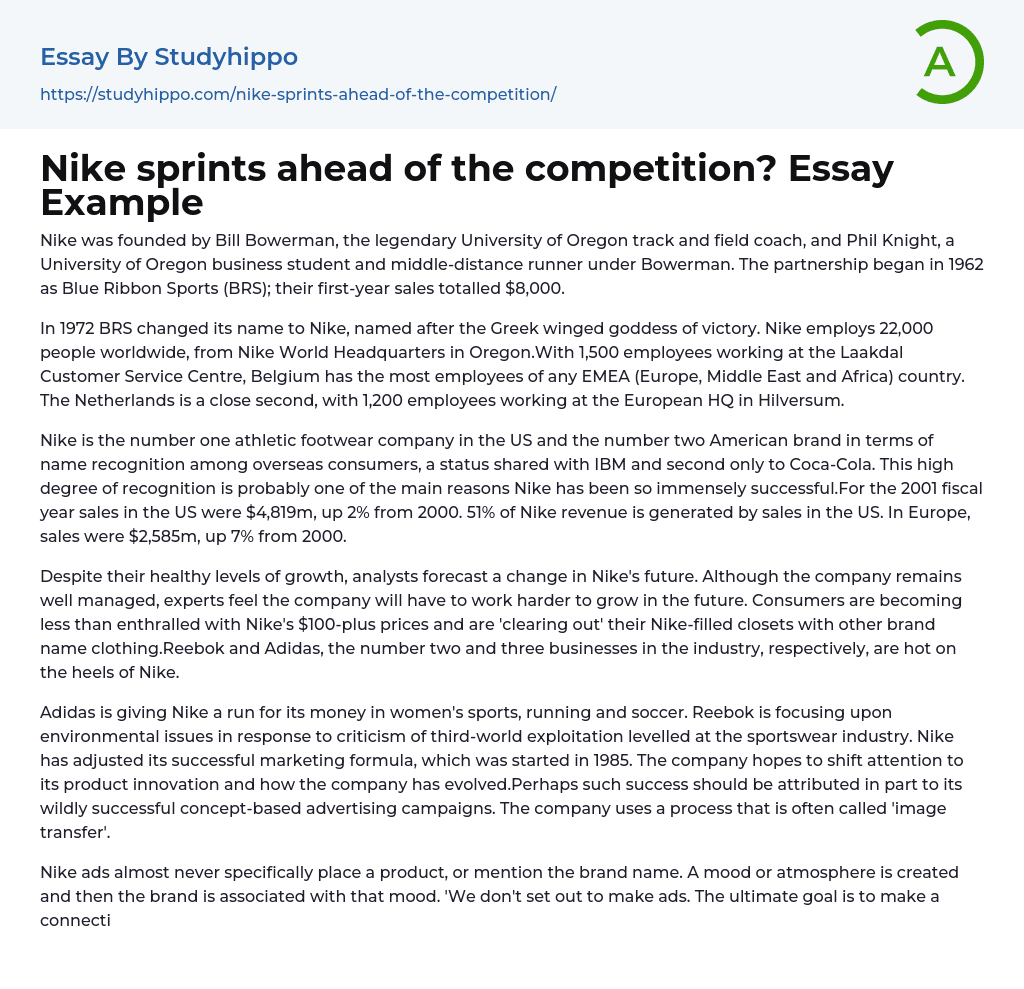In 1962, Phil Knight launched Nike after studying under Bill Bowerman at the University of Oregon. The company, which was initially called Blue Ribbon Sports (BRS), generated $8,000 in sales during its inaugural year.In 1972, Nike changed its name from BRS to honor the Greek god of victory. The company is based in Oregon and has a workforce of 22,000 people worldwide. In the EMEA region, the Laakdal Customer Service Centre employs the highest number of individuals at 1,500, followed closely by the European HQ in Hilversum, Netherlands with 1,200 staff members. All information is provided within .
In the United States, Nike is regarded as the leading company in athletic footwear and has obtained noteworthy recognition from customers around the world, placing it second only to Coca-Cola and equal to IBM. This recognition has played a crucial role in Nike's i
...mpressive achievements. In 2001, sales within the US accounted for 51% of Nike's total revenue and amounted to $4,819m, which was an increase of 2% from the previous year. Meanwhile, sales in Europe reached $2,585m in 2001 and grew by 7% compared to the prior year.
Experts predict changes in Nike's future despite its strong growth. While the company is still well-managed, analysts recommend that it increases efforts to maintain growth as consumers lose interest due to expensive prices above $100. This has resulted in a decrease in sales and customers turning to other branded apparel. Reebok and Adidas, ranked second and third respectively in the industry, are closely monitoring Nike.
Adidas and Nike are in competition in the fields of women's sports, running, and soccer. Meanwhile, Reebok is addressing environmental concerns due to criticism ove
third-world exploitation in the sportswear industry. Since 1985, Nike has shifted its successful marketing approach towards product innovation and company evolution. Their popular concept-based advertising campaigns that utilize 'image transfer' may also contribute to their continued success.
According to Dan Weiden, an ad agency for Nike, their goal is not to feature a specific product or mention the brand name in their ads. Instead, they focus on creating a certain mood or atmosphere and associating the brand with it in order to make a connection with their audience.
Nike has a history of using unpredictable image-based ads to market their brand. One such ad featured the Beatles and Nike athletes Michael Jordan and John McEnroe alongside non-celebrities engaged in sports to suggest that real athletes prefer Nike and that purchasing the brand may improve performance. Other ads have been shocking, like the 'Search and Destroy' campaign during the 1996 Olympics which included real imagery of blood and guts, or humorous, such as the debut ad for Michael Jordan's Jordan brand wear. This ad playfully implied that Jordan himself had a hand in production by leaving a Bulls' game at half time to visit his company and returning in time for the second half of the game.
Recently, Nike has shifted their marketing strategy to focus more on their product innovation skills, rather than their previous edgy and jokey attitude displayed in previous years. Chris Zimmerman, director of Nike's US advertising, explains: "We recognize that our advertisements need to tell consumers that we're about product innovation and not just athletes and exposure. We need to prove to consumers that we're not just slapping a whoosh [the company
trade-mark] on stuff to make a buck." Nike's new "I can" campaign features less celebrity athletes and more product usage compared to their previous "Just Do It" campaign. Competitors Reebok and Adidas have seen great success with their recently launched product-focused ads. Despite the emphasis on product innovation, Nike is not shying away from innovative marketing strategies.
Nike is concentrating on the international market as part of its new strategy, even though it may encounter significant difficulties. An insider predicts that within a few years, Nike's overseas sales will surpass its US sales. Nevertheless, the company has an obstacle to overcome because despite one-third of its business coming from abroad, domestic sales continue to generate more revenue.
Nike aims to expand into soccer and international sports, but must overhaul its marketing and distribution strategies to regain credibility as a top-tier sports shoe. The key markets that Nike seeks to strengthen are China, Germany, Mexico, and Japan. By emphasizing sports of interest in each region within their advertisements, Nike recognizes the need to cover more ground despite maintaining an advantage over competitors.
References: Jeff Jensen's articles 'Reebok and Nike go head to head in soccer battle' and 'Product innovation steps into spotlight at Nike' can be found in Advertising Age 68(18) (5 May 1997): 4 and Advertising Age 68(36) (8 September 1997): 3,48 respectively. Isabelle Sender's article 'Just do it, abroad' is available in Chain Store Age 73(10) (October 1997):121-4. The website for Nike is www.nike.com.
The two domains belong to sportswear brands, specifically reebok.com and adidas.com.
- Sales Promotion essays
- Advertising campaign essays
- Advertisement essays
- Advertising essays
- Anheuser-busch essays
- Audience Theory essays
- Brand essays
- Brands essays
- Competitor Analysis essays
- Consumer essays
- Detergent essays
- Marketing Management essays
- Marketing Mix essays
- Marketing Plan essays
- Marketing Research essays
- Marketing Strategy essays
- New Product Development essays
- Point Of Sale essays
- Price essays
- Procurement essays
- Product essays
- Product Differentiation essays
- Product Placement essays
- Promotion essays
- Promotion And Marketing Communications essays
- Research Design essays
- Retailing essays
- Trademark essays
- Business Analysis essays
- Business Plan essays
- Community Development essays
- Competition essays
- Effective Leadership essays
- Leadership Styles essays
- Mission Statement essays
- Negotiation essays
- Outsourcing essays
- Planning essays
- Public relations essays
- Reasoning essays
- Strategic Management essays
- Strategic Planning essays
- Swot Analysis essays
- Brand Equity essays
- Branding essays
- Market share essays
- Nike, Inc. essays
- Razor essays




